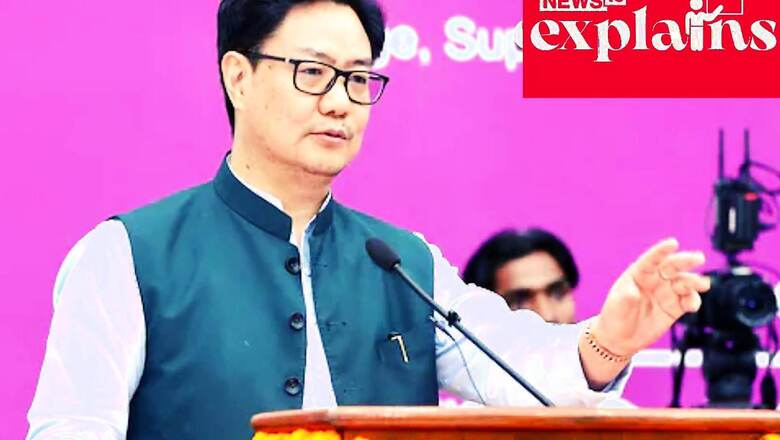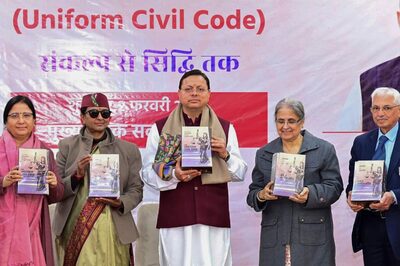
views
Law Minister Kiren Rijiju on Monday said the government’s demand for inclusion of its representatives and that of states in collegiums of the Supreme Court and high courts was the “precise follow-up action” suggested by the apex court while striking down the National Judicial Appointment Commission Act.
Rijiju made the remarks while responding to Delhi Chief Minister Arvind Kejriwal, who dubbed as “extremely dangerous” the government’s move to ask the Supreme Court to include its nominees in collegium.
“I hope you honour Court’s direction! This is precise follow-up action of the direction of the Supreme Court Constitution Bench while striking down the National Judicial Appointment Commission Act. The SC Constitution Bench had directed to restructure the MoP (Memorandum of Procedure) of the collegium system,” the minister said on Twitter.
I hope you honour Court’s direction! This is precise follow-up action of the direction of Supreme Court Constitution Bench while striking down the National Judicial Appointment Commission Act. The SC Constitution Bench had directed to restructure the MoP of the collegium system. https://t.co/b1l0jVdCkJ— Kiren Rijiju (@KirenRijiju) January 16, 2023
What Did Rijiju Send to CJI?
The Union law minister had written to Chief Justice of India D Y Chandrachud suggesting the inclusion of representatives of the Union and state governments in the Supreme Court and high court collegiums respectively to infuse transparency and public accountability in the selection of judges.
In November, Rijiju had said that the collegium system of making judicial appointments was “alien” to the Constitution. Vice President and Rajya Sabha Chairman Jagdeep Dhankhar and Lok Sabha Speaker Om Birla have also claimed that the judiciary was encroaching on the powers of the legislature.
A parliamentary panel too had expressed surprise that the government and the Supreme Court Collegium have failed to arrive at a consensus on the memorandum of procedure (MoP), guiding the appointment, elevation and transfer of apex court and high court judges, even after almost seven years.
In a recent report, the department-related Standing Committee on Law and Justice and Personnel said it expects the government and the judiciary to finalise the revised MoP, “which is more efficient and transparent”, in terms of a Supreme Court observation.
“The committee is surprised to note that the Supreme Court and the government have failed to reach a consensus on the revision of the Memorandum of Procedure (MoP) for appointment of judges to the constitutional courts (SC and the 25 HCs), though the same is under consideration of both for about seven years now,” the panel headed by veteran Bharatiya Janata Party (BJP) leader Sushil Kumar Modi said.
What Was the NJAC Judgement?
The National Judicial Appointments Commission (NJAC) was a proposed body that would have been in charge of recruiting, appointing, and transferring judicial officers, legal officers, and legal employees for the Indian government and all state governments.
The commission was established by amending the Indian Constitution for the 99th time with the Constitution (Ninety-Ninth Amendment) Act, 2014, which was passed by the Lok Sabha on 13 August 2014 and the Rajya Sabha on 14 August 2014.
The NJAC would have created a new system to replace the collegium system for appointing judges, as invoked by the Supreme Court through judicial fiat.
Along with the Constitution Amendment Act, the Parliament of India also passed the National Judicial Appointments Commission Act, 2014, to govern the functions of the National Judicial Appointments Commission.
The NJAC Bill and the Constitutional Amendment Bill were ratified by 16 Indian state legislatures before being signed by India’s President, Pranab Mukherjee, on December 31, 2014. The NJAC Act and the Constitutional Amendment Act went into effect on April 13, 2015.
The apex court had in its 2015 verdict struck down the NJAC Act and the Constitution (99th Amendment) Act, 2014, leading to the revival of the Collegium system of existing judges appointing judges to constitutional courts.
The bench, headed by the then CJI J S Khehar, asserted:”In the matter of appointment of judges to the higher judiciary, as also in the matter of their transfer, the primacy in the decision-making process inevitably rests with the Chief Justice of India.” In December 2015, the Supreme Court bench said views of the Centre and states should be taken into account and asked the government to prepare a MOP in consultation with the Chief Justice of India to enable transparency in the collegium system of appointment of judges.
It also asked the Centre to take into consideration suggestions on issues of eligibility, transparency, setting up the Secretariat for the appointment of judges, redressal of complaints and other issues in the MOP on the appointment of judges.
What is the Difference in What Rijiju Has Said in Letter, and the NJAC System?
The main difference lies in the fact that Rijiju’s letter proposes for government representation in the existing Collegium system instead of wanting an altogether new forum.
In November, Rijiju had said that the collegium system of making judicial appointments was “alien” to the Constitution.
A parliamentary panel too had expressed surprise that the government and the Supreme Court Collegium have failed to arrive at a consensus on the MoP, guiding the appointment, elevation and transfer of apex court and high court judges, even after almost seven years.
To Understand This Better, Let’s Look at the Composition in NJAC
- The ex officio Chairperson would have been the Chief Justice of India.
- Ex officio members would have included two of the Supreme Court’s most senior justices.
- As an ex officio member, the Union Minister of Law and Justice.
- Two eminent members of civil society (to be nominated by a committee comprised of the Chief Justice of India, the Prime Minister of India, and the Leader of the Opposition in the Lok Sabha; one eminent member from SC/ST/OBC/minorities or women).
And What is the Composition of Collegium?
- The Supreme Court Collegium is a five-member body led by the current Chief Justice of India (CJI) and comprised of the court’s four senior most judges at the time.
- A High Court collegium is led by the current Chief Justice and two other of the court’s most senior judges.
- The government may also object to and seek clarification on the collegium’s selections, but if the collegium repeats the same names, the government is obligated to appoint them as judges.
So, What Is the Opposition Saying?
Congress leader Ramesh alleged that the government was seeking “complete subservience”.
“The VP’s assaults. The Law Minister’s attacks. All this is orchestrated confrontation with the judiciary to intimidate and thereafter capture it totally. The Collegium needs reform. But what this Govt wants is complete subservience- It’s remedy is a poison pill for the judiciary,” Congress leader Ramesh said.
Rajya Sabha MP and former law minister Kapil Sibal has also accused the government of attempting to “capture” the judiciary and said it was trying its best to create a situation in which the NJAC in “another avatar” may be tested in the Supreme Court once again.
Sibal, 74, asserted the basic structure doctrine as enunciated in the Kesavananda Bharati verdict was very important in current times and dared the government to openly say if that is flawed.
He claimed the government has not adjusted to the fact that it does not have the final word on appointments in higher judiciary and resents it.
“They are trying their best to create a situation in which the National Judicial Appointments Commission (NJAC) in yet another avatar may be tested in the Supreme Court once again,” Sibal told PTI in an interview.
With inputs from PTI
Read all the Latest Explainers here




















Comments
0 comment